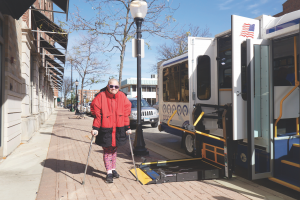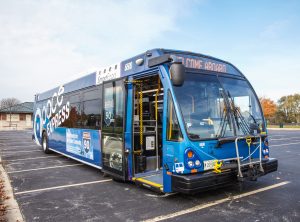By Ed Madden, Coordinator for Public Outreach, Pace Suburban Bus
Everyone needs to get from place to place safely, but sometimes the “how” can be more challenging. For many, public transportation is a great way to get around. However, the process can feel intimidating if you’re not prepared. That’s why we’re sharing five ways people with disabilities can feel empowered when riding with Pace. Whether you’re traveling on the fixed-route bus or using Pace’s ADA Paratransit service, here are some tips to apply to your next trip.
1. First, understand the process for getting on the bus
Before you can get on your way, there are a few things you’ll need to know. If you’re riding the fixed route, it’s important to figure out your bus route number and the location of the nearest stop. You’ll also want to get familiar with the bus schedule, which you can find here. Once you’re ready to get on the bus, make sure you have your Ventra card ready, or exact change if you’re paying your fare with cash.
 If you’re riding Pace’s Paratransit service, the process for getting on the bus is a bit different. You’ll need to call your local carrier (find the number here) and have key information readily available, such as your Paratransit ID number, the date and location of your trip and your requested pick-up or appointment time. Once your trip is booked, make sure you come ready with your Pace ADA One-Ride ticket, or exact fare if paying in cash. Remember, the Paratransit service is only available the same days and times as nearby fixed routes, so the fixed route is a great option to explore first because it offers more flexibility and doesn’t require you to schedule trips in advance.
If you’re riding Pace’s Paratransit service, the process for getting on the bus is a bit different. You’ll need to call your local carrier (find the number here) and have key information readily available, such as your Paratransit ID number, the date and location of your trip and your requested pick-up or appointment time. Once your trip is booked, make sure you come ready with your Pace ADA One-Ride ticket, or exact fare if paying in cash. Remember, the Paratransit service is only available the same days and times as nearby fixed routes, so the fixed route is a great option to explore first because it offers more flexibility and doesn’t require you to schedule trips in advance.
 2. Let the driver know if you need additional assistance
2. Let the driver know if you need additional assistance
Your driver is here to help, but it’s important to understand that he or she won’t necessarily know what kind of help you might need. Don’t be afraid to let your driver know where you need to get off, or if you need to use the ramp to get on and off the bus. If you’re riding on Pace Paratransit, drivers can even help you on and off the bus – but only if they know you need assistance.
3. Know your driver’s role
Getting you from Point A to Point B safely is your driver’s top priority, and while there are many ways your driver can help along the way, there are some limitations to be aware of. On the fixed route, your driver won’t be able to leave his spot behind the wheel, so make sure you travel with a personal care attendant (PCA) or companion if you know you’ll need assistance reaching your final destination. When traveling on Pace Paratransit, drivers will be able to help you on and off the bus, but it’s important to remember that they must always maintain a line of sight with the vehicle for the safety of other passengers. Therefore, if you need a helping hand beyond this point, you’ll need to enlist a trusted companion to travel with you.
4. Travel with a PCA or companion if you need one
The Hop on the Bus to Independence workshops hosted by JJ’s List are an excellent way to learn how to ride the fixed-route bus independently, but there are many situations and occasions when riding with a companion (such as a friend or family member) or a certified PCA could make sense for you. For instance, if you or a loved one have identified that you might need some help locating your final destination. If you have been certified by the RTA to travel with a PCA, your PCA can ride the fixed-route bus for half price. On ADA Paratransit, a PCA accompanying a rider who has received this certification can travel free of charge. Otherwise, companions can travel with you on both bus services for the regular fare.
Always remember that Pace’s fixed route and Paratransit service are both forms of public transportation, so no matter which one you take, a driver will not be able to meet the same needs that a qualified PCA would.
5. Practice safety on and off the bus
Safety is Pace’s top priority, so it’s important to know how to play your part in ensuring a safe trip. Here are some tips:
- For fixed-route riders: When waiting for a fixed-route bus, be sure to stand on the sidewalk where the bus driver can see you and you’re a safe distance away from traffic. Once you’re safely on the bus, it’s important to remember to take a seat or hang onto a pole, strap or railing if a seat isn’t available. If you need accessible seating (for instance, if you use a wheelchair), you can always find it at the front of the bus – just politely ask other passengers to move if those seats are in use. You should also wait until the bus stops completely before approaching the door. When it’s safe to exit the bus, remember not to cross in front of it, because the bus keeps going. Go to a crossing intersection and wait for the walk sign.
- For Pace ADA Paratransit riders: On Pace ADA Paratransit, you won’t need to wait on the sidewalk since your driver will arrive within the window of time scheduled. However, you will need to be ready to board the vehicle when your driver arrives. It’s still important to stay seated until the vehicle stops completely on ADA Paratransit, and to be aware of your surroundings when exiting the vehicle and traveling to your final destination.
These tips will make your first trip on the bus much easier, and there are plenty more where these came from. The best way to prepare for your first bus ride is to attend a JJ’s List Hop on the Bus to Independence workshop, where you’ll have a chance to get on the bus and learn the ropes from a Pace representative. To learn more about our Hop on the Bus trainings, click here.







No Comments
No comments yet.